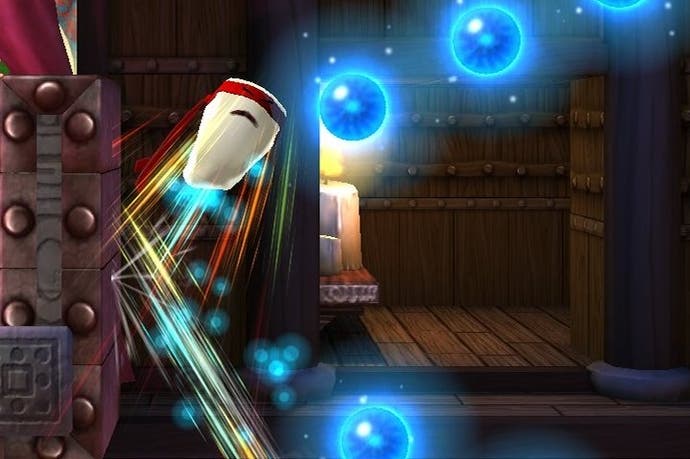Meet the gaming star of the new Amazon Fire Phone
And you may already recognise him.
To-Fu used to be a square. Now he's a cube. That's technology moving forward, isn't it? Next stop: n-dimensional hypercube!
A few weeks back, I saw To-Fu in his latest incarnation, running on Amazon's forthcoming Fire Phone, where his new game To-Fu Fury is part of the launch line-up. The phone itself was a pre-release unit, its form all but hidden by a bulky case and its OS off-limits, so I couldn't check out the finer details, like menus you can move through by tilting, or the deep, probably terrifying integration of the Amazon store into many of the handset's peripheral features. I did get to see the nice big screen that changes perspective based on the position of your eyes, though, and I did get to play a bit of To-Fu's latest adventure and talk to the people making it.
Firstly, that head-tracking stuff. It's powered, I gather, by a handful of little cameras studded around the outside of the screen, and it works, in essence, like tilt, except you don't have to actually tilt your handset physically - you just cast your eyes about instead. It's responsive and capable, and it's weird how quickly it starts to feel natural - so natural, in fact, that it's initially surprisingly hard to get your head around what's changed. But yes, you move your eyes, and the screen shifts in line with your perspective, allowing for an almost tangible sense of physicality to the 3D images displayed. In a game like To-Fu it gives the world a real blockish presence, while also allowing you to easily see what's above you, what's below you, and what's around the next corner. (In the final unit, you'll apparently be able to zoom in by moving your head in close, too - the next-gen version of pinch, if you will. You'll possibly look a bit silly, but it should be a nice novelty.)
As for To-Fu itself, Fury is a brand new game, which means a brand new suite of devious platforming levels to navigate. To-Fu still still sticks to walls, collects orbs and other doodads, and has to make his way through increasingly complex gauntlets by pinging from one surface to the next - I love the way you aim by stretching him forward rather than pulling him back, allowing for real precision - but there are plenty of tweaks heralding his new launch title status.

So yes, he's now a cube, and his world, while still working on a 2D plane, is rendered in chunky and colourful 3D. Beyond that, Fury features a proper storyline for the first time along with a range of supporting characters, as To-Fu moves from the Dojo to locations like a palace and a monastery up in the mountains. The more fiendish levels have been hived off - they're available on a separate challenge island where they won't interrupt the plot - but even the simpler areas see To-Fu learning new abilities. The super-ping's now used to attack enemies and screen-filling bosses as well as to bust through obstacles in the environment, and it's joined by a fling, where you do pull To-Fu back and then release him, sending him in a graceful arc, Angry Birds-style.
It looks typically lovely, but the most interesting thing about To-Fu Fury is possibly the backing it's had from Amazon. Could this be a smartphone platform holder that's ready to treat games with a little more care than the rest?
Possibly. "It's been amazing," says HotGen's CEO, Terry Haynes. "The guys who are there at Amazon are all gaming guys. They've all come from big studios, some ex-Microsoft guys, some ex-Activision guys. They're a really good bunch of people who have worked on a great bunch of products. The great thing about them, too, is that they've all come from a development background. So when there's a new device, they all understand from a development point of view how we work and what we'll need to achieve the things we want to achieve. They know how to support it."
"Without being disparaging to other publishers, I can only say it's really refreshing," agrees senior producer Darren Anderson, stuffing the Amazon Fire - and To-Fu - back in a jacket pocket. "It sounds like I'm paid to say that, but they do what you want them to do. They offer advice when you need it, but they're right behind you. They're part of the process. After all, the market dictates that these devices are used for games as much as utilities and anything else." He shrugs. "It would be kind of odd if they didn't support games."

